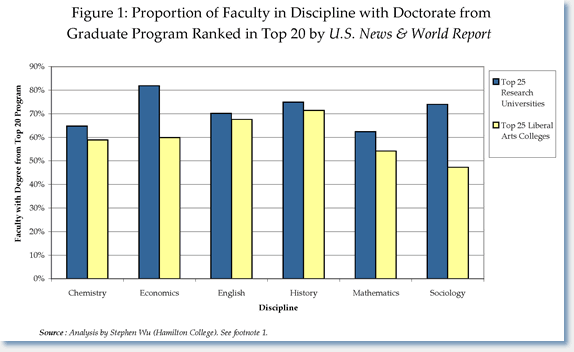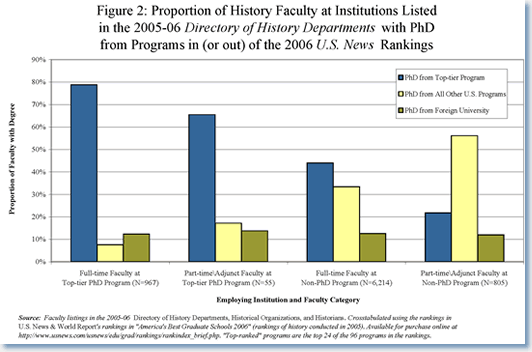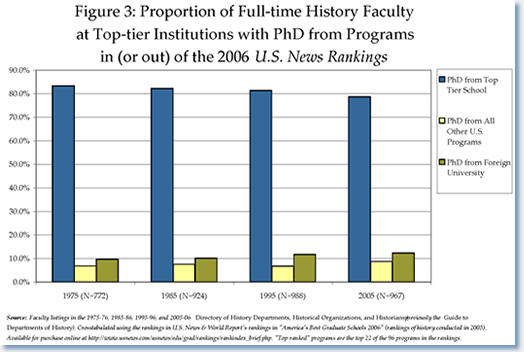News
New Study Highlights Prominence of Elite PhD Programs in History
Elite history departments tend to draw their faculty from elite PhD programs, economist Stephen Wu reports in the July–August 2005 issue of Academe (the magazine published by the American Association of University Professors). That is hardly news to anyone in the profession, but Wu's analysis provides some context by comparing history to five other disciplines. The analysis also offers a useful starting point for a wider look at the history faculty listed in the AHA's annual Directory of History Departments, Historical Organizations, and Historians, opening up a new and larger set of questions about elitism in the profession and what constitutes "success" in the placement of history PhDs. What such a broader (and deeper) analysis suggests is that measures of success and elitism of the field are a bit more complex than a simple tabulation of where faculty received their PhDs.
Wu collected degree information for just over 5,000 full-time faculty in six disciplines (chemistry, economics, English, history, mathematics, and sociology) who are now employed at liberal arts colleges and universities ranked as the top 25 in the U.S. News and World Report rankings. He was thus able to cross tabulate information for these faculty members to determine who among them had obtained their PhDs from departments that are ranked among the top 10 and 20 programs in the U.S. News rankings for each discipline.
While the U.S. News rankings are often maligned for the subjectivity of their quality ratings, Wu's findings do suggest some underlying validity in the ratings, at least as a predictor for academic employment. For instance, among faculty employed at history departments in the top-rated "national universities," 58.9 percent had received their PhDs from the top 10 programs in the U.S. News rankings. This is less pronounced than in the case of the faculty in economics departments, where 67.3 percent of the faculty had degrees from the top 10 schools, and is just a bit above the English departments, where 57.1 percent of their faculty had received degrees from a program in the top 10.
When Wu takes a wider perspective, to include PhDs from departments ranked among U.S. News's top 20 programs in the discipline (Figure 1), economics departments still appeared to draw most heavily from top-ranked programs in the field, with history a distant second. Economics departments at the highest-rated research universities drew 82 percent of their full-time faculty from the top 20 programs in their field. In comparison, history departments drew 74.9 percent of their faculty from the similarly ranked programs. This compares to 74.0 percent of sociology faculty, and 70.2 percent of English faculty. The faculty in the harder sciences—chemistry and mathematics—drew less than 65 percent of their faculty from the top 20 schools.

At the top-ranked liberal arts colleges, the history faculty stands out as a bit more likely to have come from the elite PhD programs. At these colleges, 71.6 percent of the history faculty came from the top 20 PhD programs. This compares to 67.6 among the English faculty, and less than 60 percent of the faculty in the other four disciplines. Faculty in the discipline of sociology had the broadest range of PhD programs represented, with only 47.6 percent of their faculty coming from the top 20 PhD programs.
Wu cites his findings as evidence that "attending a highly rated graduate institution is paramount to landing a prestigious academic job upon graduation." While his evidence certainly seems to validate common perceptions on this point, it is important to view both ends of the pipeline, and consider how large a portion of the history PhD population emerges from these top-ranked PhD programs. To get a sense of the relative scale—in terms of the number of PhDs produced—of the top-ranked degree programs, it is important to note that for the field of history, the top 10 programs conferred 28 percent of the PhDs in the discipline over the past 15 years, while the top 20 programs conferred 44 percent of the new doctorates.1
This bears equal attention relative to the other disciplines in Wu's survey. History appears unusual among the disciplines selected for having a disproportionate number of degrees conferred by the top 20 programs in the rankings. Among the other disciplines, the top 20 programs conferred less than a quarter of the PhDs in the field (less than 20 percent in chemistry and English), and only in economics did PhDs from programs in the top 20 programs comprise more than 40 percent of the new PhDs. The top 20 programs accounted for less than a third of the new doctorates in English and chemistry.
When we take both ends of the pipeline into account (the schools conferring the PhDs and the schools hiring them), the employment pattern of history PhDs does not appear quite so far out of line from the other disciplines. The proportion of history PhDs from the top 10 programs now employed at elite universities is 2.2 times their representation among degrees conferred over the past 15 years (58.9 percent of the faculty as compared to 28 percent of the new PhDs). The representation of history PhDs from the top 20 programs is 1.7 times their portion of the PhDs conferred. While the top-ranked history PhD programs have a clear advantage in placing their students at elite institutions, this benefit is notably smaller than the comparable ratios among the other disciplines in Wu's report. The top 10 English programs, for instance, place 3.0 times their increment of the PhDs conferred, while the top 20 programs place 2.1 times their proportion of PhDs conferred. Similarly, in the field of economics, the top 10 programs accounted for 2.9 times their representation among doctorates in the field, and 2.0 times their representation of the PhDs from the top 20 programs.
The evidence is similar for placements among liberal arts programs, where the same comparison of the proportions of PhDs conferred to the proportion of their PhDs placed shows history lagging behind the fields of English and chemistry and just barely above the other fields except sociology.
A Closer Look at History
Using the information supplied for the latest edition of the AHA Directory of History Departments, we can expand beyond Wu's analysis for the history discipline—looking beyond the top 25 programs to a much wider range of departments employing history PhDs, while also including faculty who are not employed full time. Our findings tend to confirm Wu's basic analysis, but also provide some important details about the employment of PhDs from elite institutions and troubling details on the issue of part-time faculty.
If we look at the faculty employed in the top quartile of programs conferring history PhDs in the latest U.S. News rankings, we do find a relatively closed circuit of PhDs and employment. As shown in Figure 2, almost 80 percent of the full-time faculty listed at those programs received their degrees from either the same program or another program in the same tier of the rankings.2

Viewed historically, these proportions have changed very little over the past 30 years (see Figure 3). In the 1975–76 Directory, 83.4 percent of the full-time faculty at these schools had earned their PhD from one of the top-tier schools. While the concentration of PhDs from the top-tier schools diminished over the past 30 years, much of the change has come from growth in the proportion of foreign PhDs. In 1975, 9.7 percent of the faculty at these schools had earned their degrees abroad, as compared to 12.3 percent in the most recent Directory. Indeed, the proportion of the faculty in these elite departments who received PhDs from overseas universities is greater than those who received PhDs from the 165 U.S. institutions not included in the top tier, which also conferred degrees in the field. The number of PhDs from other domestic PhD programs only rose from 6.9 percent in 1975 to 8.8 percent today.3 While our data cannot prove the point, this fits with our perceptions that elite programs tend to hire faculty later in their careers.

The dominance of PhDs from the top-tier schools diminishes sharply when we look at history departments that do not confer a history PhD. Only 44 percent of full-time faculty at these departments earned PhDs from a top-tier institution, while 33 percent earned their degrees from one of the other domestic programs, and 12 percent earned their degrees overseas. Given that disparity in the employment of history PhDs, it is important to note that departments that do not confer PhDs employ 65 percent of the full-time faculty listed in the AHA Directory.
It is also important to note that while the top-ranked programs have conferred a disproportionate number of the history PhD degrees over the past 15 years, they have not been major employers of new PhDs over that span. The median year in which faculty at top-ranked PhD programs received their PhDs is five years older than faculty at the non-PhD programs. Put more precisely, 41 percent of the full-time faculty at the top-tier PhD programs received their PhDs before 1980, while only 37 percent have received their PhDs in the past 15 years. In comparison, at programs without a PhD program, 26.5 percent of the full-time faculty earned their PhDs before 1980, while 55.1 percent have earned the PhD since 1990.
As we noted in our most recent survey of the academic job market, while a larger proportion of PhDs from the top-tier programs (as compared to other programs) do land academic jobs, it is also true that a larger number of students from the top-tier programs are not finding employment in the academy.4 While almost half of the new history PhDs from top tier schools over the past 15 years found employment at a program listed in the AHA's Directory of History Departments, even programs at the bottom of the rankings placed around a quarter of their PhDs into listed departments.
A starker difference appears when we look at the data on faculty employed part time in history departments. At the top-ranked programs the proportion of part-time faculty with degrees from schools outside the top-tier is twice their representation among full-time faculty (17 percent of the part-time faculty, as compared to 8 percent of the full-time faculty, have PhDs from the schools in the other tiers of the U.S. News listings). The disparities are more even pronounced at the departments without PhD programs (which employ almost three-fourths of the part-time faculty listed in the Directory) where just 22 percent have degrees from programs in the top tier, and 56 percent earned degrees at other programs.
Unfortunately, while we can mark the clear difference, it is much more difficult to pin down an explanation. While the common perception of part-time faculty is that of the "freeway flyer"—stringing together a number of grotesquely underpaid and geographically dispersed appointments in order to eke out a living—our surveys of the field have shown a more complex picture. A majority of the respondents to our surveys indicate that many of the faculty who appear on our lists as employed part time are teaching as an avocation, while earning a living through other employment.5
The data from the Directory does not help us distinguish between those pursuing a noble dream and those seeking a livelihood (which are often overlapping aims in any case); so we need to be cautious about leaping to the easy conclusion that the lower-ranked programs are the primary recruiting grounds for the new proletariat of the history profession. It is worth noting, however, that our surveys have consistently shown a profound sense of bitterness and alienation among faculty employed part time in history departments, many of whom feel that their full-time colleagues are too often aloof and distant. One might reasonably wonder whether some of this distance and aloofness is derived from a bit of snobbery not only about their employment status but also about where they received their degrees.
—Robert Townsend is AHA assistant director for research and publications.
Notes
1. Tabulation of the number of institutions conferring PhDs in each discipline 1994 to 2003, drawn from data in the National Science Foundation's WebCaspar system at http://caspar.nsf.gov/. Viewed from a historical perspective, one could also object to the use of U.S. News rankings in 2004 to assess the degrees of faculty where a majority earned they degree more than 15 years ago (at least in history departments).
2. It should be noted that while Wu used the rankings available in 2004, we have done our tabulations based on the rankings that were published this year, published in U.S. News's "America's Best Graduate Schools 2006," and available online at http://www.usnews.com/usnews/edu/grad/rankings/phdhum/brief/hisrank_brief.php.
3. Tabulations used the same cohort of schools in analyzing against the 1975–76, 1985–86, and 1995–96 data, even though one presumes that there would have been some fluctuation in the rankings over that span.
4. Robert B. Townsend, "Job Market Report 2004," Perspectives 43:1 (January 2005): 13–19. See also Robert B. Townsend, "Privileging History: Trends in the Undergraduate Origins of History PhDs," Perspectives 43:6 (September 2005): 14–20.
5. Robert B. Townsend and Miriam E. Hauss, "The 2002 AHA-OAH Survey of Part-Time and Adjunct Faculty," Perspectives (October 2002).
Tags: Graduate Education
Comment
Please read our commenting and letters policy before submitting.






